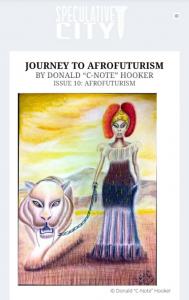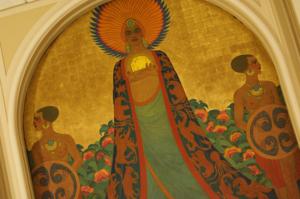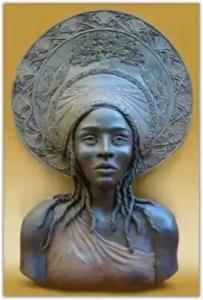The Announcement of the Other Woman King for Black History Month Celebrations

(l) Queen Califia in the poem 'Journey to Afrofuturism' and (r) General Nanisca in the movie 'The Woman King'
When the African Moors occupied Europe, the Spaniards in 1510, created a Black Woman King to which California was named after her.
SILICON VALLEY, CALIFORNIA, UNITED STATES, February 28, 2023 /EINPresswire.com/ -- On Sunday, March 12th, 2023, at the Oscar awards ceremony in Los Angeles, California, there will be nobody to accept an award for the TriStar Pictures's "The Woman King," because it was not selected in any Oscar category. Much can be debated as to why, such as racism, or gender bias, as no woman director was selected in the best director category."The Woman King" directed by Gina Prince-Bythewood and starring Viola Davis is based on the true story of the all-female warrior unit that protected the West African kingdom of Dahomey.
In the September 15, 2022, edition of the Smithsonian Magazine, "The Real Warriors Behind ‘The Woman King" by Associate Editor, History, Meilan Solly, she writes, "the Agojie, raided villages under cover of darkness, took captives and slashed off resisters’ heads to return to their king as trophies of war. Through these actions, the Agojie established Dahomey’s preeminence over neighboring kingdoms and became known by European visitors as “Amazons” due to their similarities to the warrior women of Greek myth."
However, the legend of Amazonian Black Women warriors from a Eurocentric perspective predates the Dahomey's existence by at least a century.
In the US, and UK alike, much is made about European occupation or dominance into African lands, but no serious discussion goes on about the role reversal of Africans occupying European lands.
All great Human development is associated with a body of water, from the Yangtze river in China, to the Euphrates in the Middle East, and the dominant body of water conducive to the development of Western civilization is the Mediterranean Sea.
The Phoenicians gave the Western world writing, the Greeks gave democracy, and the Romans gave republic governance. But the conversation of Africans crossing the Mediterranean to occupy Europe is rarely discussed.
In 332 B.C., when Alexander the Great reached Kemet (Ancient Egypt), he halted his armies at the borders of Ethiopia. Legends say that when Alexander attempted to conquer Ethiopia, its formidable Black Queen Candice, the Empress of Ethiopia, arranged her armies strategically to meet him and was present on a war elephant when he approached. Having assessed the strength of her armies, Alexander decided to withdraw from Nubia, heading to Egypt instead. See, Black Women For Wellness - Candace of Meroe - Queens of Ethiopia.
A century later, in 218 BC, the Black African, 28-year old Hannibal, his soldiers, and his 37 African battle elephants marched from southern Spain to the plains of northern Italy – but took an unexpected route. Instead of following the coastline or going by sea, he crossed the Alps, to the surprise of the Roman Empire army. It marked the start of the Second Punic War, in which the two empires Carthage (a North African city-state in what is Tunisia today, led by Hannibal) and the Roman Empire were fighting over the control of the Mediterranean region. See, "Which route did Hannibal and his elephants take to cross the Alps?", by Anna Thieme of Datawrapper. Datawrapper is a data visualization tool for creating charts, maps, and tables.
In the 7th century AD, Africans crossed the Mediterranean Sea from Tunis (Tunisia) and conquered the Iberian peninsula (Spain & Portugal) for 800 years, conquered parts of Gaul (France) for a period, and conquered Sicily (Italy) for over two centuries.
In 1510, Spanish novelist Garcia Ordonez Rodriguez de Montalvo, wrote "Las sergas de Esplandián." The novel describes a fictional island named California, inhabited only by Black women, and ruled by Queen Calafia. When Spanish conquistador, and Governor of Mexico, Hernán Cortés, learned of an island off the coast of Western Mexico, and rumored to be ruled by Amazon women, he sent an expeditionary force to explore the island, and when they did not return, it left such an indelible impression upon the Conquistador, it is purported he told his men, "We have arrived in Califia's land."
Rodriguez de Montalvo wrote the following in his 16th century novel, "Las sergas de Esplandián":
"Know that on the right hand from the Indies exists an island called California very close to a side of the Earthly Paradise; and black women populated it, without any man existing there because they lived in the way of the Amazons. They had beautiful and robust bodies and were brave and very strong. Their island was the strongest of the World, with its cliffs and rocky shores. Their weapons were golden and so were the harnesses of the wild beasts that they were accustomed to domesticate and ride because there was no other metal on the island than gold."
JOURNEY TO AFROFUTURISM
Every February, for the past 33 years, professor and San Francisco Bay View, Arts Editor, Wanda Sabir has held the Annual Celebration of African American Poets and Their Poetry. While poets are free to recite whatever they wish, there are annual poetry prompts based on the annual theme of the Association for the Study of African American Life and History (ASALH®). ASALH was founded by Carter G. Woodson, who was the creator of Negro History Week in 1926, now known as Black History Month.
For the 30th Anniversary Celebration of African American Poets and Their Poetry, in 2020, there were two poetry prompts, one was the 2020 national theme of ASALH, the other was a local theme, the "400 Years of California, African American History."
One of the poems submitted to be recited was based upon the local poetry prompt, the 400 years of African Americans in California. It was titled "Journey to Afrofuturism," and was written by a California prisoner. It is an allegorical poem based upon the 1985 movie "Back to the Future." In the poem, Queen Califia has been summonsed to return to nursemaid the Afrofuturism movement.
According to Jamie Broadnax of Black Girl Nerds, the Afrofuturism movement is defined as, "a reimagining of a future filled with arts, science and technology seen through a Black lens." The term was conceived a quarter century ago, by white author Mark Dery in his essay "Black to the Future," which looks at speculative fiction within the African diaspora.
The fictional land of Wakanda in the comic book series Black Panther, epitomizes the idea of this Black future.
As a follow up to the 30th Anniversary Celebration of African American Poets and Their Poetry, Sabir decided she would catalog the 30 years of the event into a book. When the prisoner was informed of this, who is also an award winning visual artist, he created a drawing to go with his poem, and entitled the drawing "Journey to Afrofuturism." In the drawing, Queen Califia is seen holding a chain leash that is tied around the neck of a Saber Tooth tiger. Saber Tooth tigers, though now extinct, once roamed the California landscape.
Speculative Fiction Magazine paid the prisoner for a limited exclusive use of the poem and artwork to be published in their Speculative Fiction Magazine, Winter 2020, #10 Afrofuturism.
On October 14th, 2021, the University of California, Santa Cruz (UCSC), held an event on Zoom entitled, "Afrofuturism Then and Now." The event was the inaugural 2021 - 2022 Academic Year Global discussion and performances on what Afrofuturism means and how it manifests in cultural practices. The Zoom call panelists consisted of speakers in diverse locations such as the Congo in Central Africa, Burkina Faso in West Africa, and several cities in the Northern California Bay Area in the United States. The event concluded with Hip Hop artist and Hip Hop Congress Board Chairman Rahman Jamaal exhibiting and reciting the artwork and poem "Journey to Afrofuturism."
In many circles of the Afrofuturism movement, the body of work called "Journey to Afrofuturism," and its Queen Califia, is seen as heralding a Spiritual Queen to the movement.
Charles Payseur of Quick Sip Reviews, who specializes in the review of Speculative fiction wrote about the poem "Journey to Afrofuturism" in this way:
"This piece speaks to me of tradition, of tracing the ideas and influences of Afrofuturism from Africa and to California, finding there a sort of forgotten, parallel history to draw off of, to complicate, and to reclaim. The piece reveals the bounty of the area, touched by a queen, the verdant and lush landscape, the way the earth seems to be so nourishing there. For me, there's a sense that the piece could almost be saying something about the "true" path of afrofuturism and how it exists in the West, how it's future is in California. But I feel instead that the poem is rather tracing not _the_ path of the movement, of afrofuturism as a whole, but rather showing how it leads not only forward, but also into the past. It's a catalyst, a way of reclaiming a history that has been largely ignored and erased. The poem to me feels like a celebration of scholarship and of art to reach back and make connections, to find afrofuturism waiting in all times, in all places. Like with the last poem, there's a feeling to me of connecting this work to a kind of collective past, one that recognizes Black excellence and endeavor, that shows that the West has never been only white. And for me the piece finds a lot of hope in that, of finding these buried roots that can still find their way to the surface and become new growth. That can connect movements across oceans and continents. Not to claim the center of the movement, of all of afrofuturism, is in California, but rather to show that the same spirit and soul of Afrofuturism existed and exists everywhere, a source of strength and power for those who look for it and who find the stories that have largely been denied to them. So that the future is not pulling out of the whitewashed version of history so many cling to, but from a past reclaimed and made whole. It's a wonderful piece."
To read "Journey to Afrofuturism", to learn more about Afrofuturism from global voices, or too see the 2023, 33rd Annual Celebration of African American Poets and Their Poetry, see the following links below:
Journey to Afrofuturism by Donald "C-Note" Hooker | Speculative City Magazine
https://speculativecity.com/poetry/journey-to-afrofuturism/
Afrofuturism Then and Now | YouTube
https://youtu.be/toSdvn7G3GQ
33rd Annual Celebration of African American Poets and Their Poetry | YouTube
https://www.youtube.com/live/CMQ7HBl4WO0
Anna D. Smith
Anna D. Smith Fine Art and Real Estate Broker
+1 408-502-0102
email us here
Visit us on social media:
Twitter
LinkedIn
Instagram
YouTube
Other




